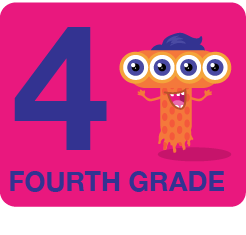This worksheet will guide you through the associative property of multiplication. First, we'll explain what it is with a couple of examples. Then, it's your turn! You'll fill in the missing numbers in multiplication problems and match your answers.
The associative property for multiplication is a special rule that helps us group numbers differently when we multiply and still get the same answer! Imagine you have three numbers to multiply, like 2, 3, and 4. You can multiply the first two numbers together like this: (2 x 3) x 4 = 6 x 4, which equals 24. Or, you can multiply the last two numbers first: 2 x (3 x 4) = 2 x 12, which also equals 24. How you group them doesn't matter; you'll always get the same answer.
Understanding the Associative Property of Multiplication
Additional Educational Resources:
Multiplication (with one factor being larger than one digit) Large Workbook - (Grade 3)
Estimation and Number Theory Large Workbook - (Grade 4)
Multiplication (Grade 3 - Math Assessment)
Factor Hunting: A Two-Part Student Exercise on Missing Factors
Properties of Multiplication: The Commutative Property
Princess Adventure through the Hundreds Maze: Counting by 100s
Understanding the Identity Property of Multiplication
Getting Familiar with Power of Tens: Multiplying and Dividing by a Power of Ten
Mastering the Distributive Property
Understanding the Associative Property of Multiplication
GRADES:


Additional Educational Resources:
Multiplication (with one factor being larger than one digit) Large Workbook - (Grade 3)
Estimation and Number Theory Large Workbook - (Grade 4)
Multiplication (Grade 3 - Math Assessment)
Factor Hunting: A Two-Part Student Exercise on Missing Factors
Properties of Multiplication: The Commutative Property
Princess Adventure through the Hundreds Maze: Counting by 100s
Understanding the Identity Property of Multiplication
Getting Familiar with Power of Tens: Multiplying and Dividing by a Power of Ten
Mastering the Distributive Property

